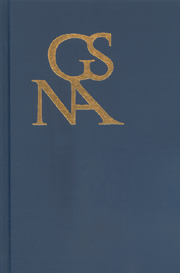Book contents
- Frontmatter
- Contents
- Towards a German Romantic Concept of the Ballad: Goethe's “Johanna Sebus” and Its Musical Interpretations by Zelter and Reichardt
- “Trübe” as the Source of New Color Formation in Goethe's Late Works Entoptische Farben (1817–20) and Chromatik (1822)
- The Myth of Otherness: Goethe on Presence
- The Transformation of the Law of Nations and the Reinvention of the Novella: Legal History and Literary Innovation from Boccaccio's Decameron to Goethe's Unterhaltungen deutscher Ausgewanderten
- “Hear him! hört ihn!”: Scholarly Lecturing in Berlin and the Popular Style of Karl Philipp Moritz
- Hypochondria, Onanism, and Reading in Goethe's Werther
- Judex! Blasphemy! and Posthumous Conversion: Schiller and (No) Religion
- Esoterik der “Macht, die über uns waltet und alles zum Besten lenkt”: Das Wissen vom Anderen in Goethes Wilhelm Meisters Lehrjahre
- Goethes Fortgepflanztes: Zur Unbegrifflichkeit der Morphologie
- Special Section on Die Entstehung der Neueren deutschen Literaturwissenschaft aus der Goethe-Philologie
- Book Reviews
“Trübe” as the Source of New Color Formation in Goethe's Late Works Entoptische Farben (1817–20) and Chromatik (1822)
Published online by Cambridge University Press: 05 February 2013
- Frontmatter
- Contents
- Towards a German Romantic Concept of the Ballad: Goethe's “Johanna Sebus” and Its Musical Interpretations by Zelter and Reichardt
- “Trübe” as the Source of New Color Formation in Goethe's Late Works Entoptische Farben (1817–20) and Chromatik (1822)
- The Myth of Otherness: Goethe on Presence
- The Transformation of the Law of Nations and the Reinvention of the Novella: Legal History and Literary Innovation from Boccaccio's Decameron to Goethe's Unterhaltungen deutscher Ausgewanderten
- “Hear him! hört ihn!”: Scholarly Lecturing in Berlin and the Popular Style of Karl Philipp Moritz
- Hypochondria, Onanism, and Reading in Goethe's Werther
- Judex! Blasphemy! and Posthumous Conversion: Schiller and (No) Religion
- Esoterik der “Macht, die über uns waltet und alles zum Besten lenkt”: Das Wissen vom Anderen in Goethes Wilhelm Meisters Lehrjahre
- Goethes Fortgepflanztes: Zur Unbegrifflichkeit der Morphologie
- Special Section on Die Entstehung der Neueren deutschen Literaturwissenschaft aus der Goethe-Philologie
- Book Reviews
Summary
Ohne Durchscheinen giebts keine Farbe. Die durchscheinende Trübe ist und bleibt das Element aller Chroagenesie.
(Goethe, FA 1.20:528)Much has been written about Goethe's earlier didactic and polemical works on color. However, little attention has been paid to his late essays titled Entoptische Farben (1817-20) and Chromatik (1822), on which I shall focus in this essay. Goethe's experiments with colors and his writings on the visual occupied him almost for his entire life. Whereas one group of scholars argues for continuity and consistency in Goethe's works, a second group argues that his oeuvre displays gaps and discontinuities, yet that these various parts represent different voices dialogically responding to each other while in the process also forming a coherent whole. A third group has attempted to structure Goethe's extensive work on color and has divided it into several distinct phases arguing for certain breaks in between. Convincing arguments can be made for all three of these various approaches to Goethe's writings on color and seeing.
In this essay I wish to continue on the path taken by scholars from the third group, especially Rupprecht Matthaei and Frederick Burwick, but to confine myself specifically to the essays Entoptische Farben (1817-20) and Chromatik (1822). I will argue that Goethe in his late work introduces something relatively innovative to his analysis, especially in the material following 1817. While I shall consider these works together, it is debatable whether or not they can be subsumed together under a single heading as the final phase in Goethe's work on color, although the arguments for and against cannot be taken up at this time.
- Type
- Chapter
- Information
- Goethe Yearbook 19 , pp. 29 - 48Publisher: Boydell & BrewerPrint publication year: 2012



